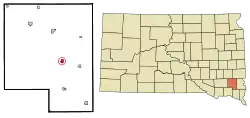Hurley, South Dakota
Hurley is a city in Turner County, South Dakota, United States. The population was 415 at the 2010 census.
Hurley, South Dakota | |
|---|---|
 Location in Turner County and the state of South Dakota | |
| Coordinates: 43°16′57″N 97°5′18″W | |
| Country | United States |
| State | South Dakota |
| County | Turner |
| Incorporated | 1883[1] |
| Area | |
| • Total | 0.62 sq mi (1.59 km2) |
| • Land | 0.62 sq mi (1.59 km2) |
| • Water | 0.00 sq mi (0.00 km2) |
| Elevation | 1,283 ft (391 m) |
| Population | |
| • Total | 415 |
| • Estimate (2019)[4] | 399 |
| • Density | 647.73/sq mi (250.24/km2) |
| Time zone | UTC-6 (Central (CST)) |
| • Summer (DST) | UTC-5 (CDT) |
| ZIP code | 57036 |
| Area code(s) | 605 |
| FIPS code | 46-30980[5] |
| GNIS feature ID | 1255718[6] |
History
Hurley was platted in 1883.[7] It was named for R. E. Hurley, a railroad engineer.[7] A post office has been in operation in Hurley since 1883.[8]
Geography
Hurley is located at 43°16′57″N 97°5′18″W (43.282397, -97.088463).[9]
According to the United States Census Bureau, the city has a total area of 0.62 square miles (1.61 km2), all land.[10]
Hurley has been assigned the ZIP code 57036 and the FIPS place code 30980.
Demographics
| Historical population | |||
|---|---|---|---|
| Census | Pop. | %± | |
| 1890 | 344 | — | |
| 1900 | 444 | 29.1% | |
| 1910 | 506 | 14.0% | |
| 1920 | 586 | 15.8% | |
| 1930 | 586 | 0.0% | |
| 1940 | 586 | 0.0% | |
| 1950 | 474 | −19.1% | |
| 1960 | 450 | −5.1% | |
| 1970 | 399 | −11.3% | |
| 1980 | 419 | 5.0% | |
| 1990 | 372 | −11.2% | |
| 2000 | 426 | 14.5% | |
| 2010 | 415 | −2.6% | |
| 2019 (est.) | 399 | [4] | −3.9% |
| U.S. Decennial Census[11] | |||
2010 census
At the 2010 census there were 415 people in 179 households, including 120 families, in the city. The population density was 669.4 inhabitants per square mile (258.5/km2). There were 204 housing units at an average density of 329.0 per square mile (127.0/km2). The racial makup of the city was 97.1% White, 0.2% African American, 1.0% Native American, and 1.7% from two or more races. Hispanic or Latino of any race were 2.4%.[3]
Of the 179 households 30.7% had children under the age of 18 living with them, 52.5% were married couples living together, 10.6% had a female householder with no husband present, 3.9% had a male householder with no wife present, and 33.0% were non-families. 30.2% of households were one person and 12.8% were one person aged 65 or older. The average household size was 2.32 and the average family size was 2.82.
The median age was 35.9 years. 27% of residents were under the age of 18; 6.6% were between the ages of 18 and 24; 26.7% were from 25 to 44; 23.9% were from 45 to 64; and 15.9% were 65 or older. The gender makeup of the city was 49.4% male and 50.6% female.
2000 census
At the 2000 census there were 426 people in 187 households, including 123 families, in the city. The population density was 690.4 people per square mile (265.3/km2). There were 206 housing units at an average density of 333.8 per square mile (128.3/km2). The racial makup of the city was 99.77% White and 0.23% Asian. Hispanic or Latino of any race were 0.23%.[5]
Of the 187 households 27.8% had children under the age of 18 living with them, 54.5% were married couples living together, 8.6% had a female householder with no husband present, and 33.7% were non-families. 30.5% of households were one person and 17.1% were one person aged 65 or older. The average household size was 2.28 and the average family size was 2.82.
The age distribution was 23.0% under the age of 18, 6.6% from 18 to 24, 25.6% from 25 to 44, 24.2% from 45 to 64, and 20.7% 65 or older. The median age was 41 years. For every 100 females, there were 86.0 males. For every 100 females age 18 and over, there were 85.3 males.
The median household income was $35,313 and the median family income was $47,083. Males had a median income of $29,737 versus $21,484 for females. The per capita income for the city was $18,319. About 4.9% of families and 7.2% of the population were below the poverty line, including none of those under age 18 and 14.0% of those age 65 or over.
References
- "SD Towns" (PDF). South Dakota State Historical Society. Archived from the original (PDF) on 2010-02-10. Retrieved 2010-02-13.
- "2019 U.S. Gazetteer Files". United States Census Bureau. Retrieved July 30, 2020.
- "U.S. Census website". United States Census Bureau. Retrieved 2012-06-21.
- "Population and Housing Unit Estimates". United States Census Bureau. May 24, 2020. Retrieved May 27, 2020.
- "U.S. Census website". United States Census Bureau. Retrieved 2008-01-31.
- "US Board on Geographic Names". United States Geological Survey. 2007-10-25. Retrieved 2008-01-31.
- Chicago and North Western Railway Company (1908). A History of the Origin of the Place Names Connected with the Chicago & North Western and Chicago, St. Paul, Minneapolis & Omaha Railways. p. 85.
- "Turner County". Jim Forte Postal History. Retrieved 20 March 2015.
- "US Gazetteer files: 2010, 2000, and 1990". United States Census Bureau. 2011-02-12. Retrieved 2011-04-23.
- "US Gazetteer files 2010". United States Census Bureau. Archived from the original on 2012-01-25. Retrieved 2012-06-21.
- "Census of Population and Housing". Census.gov. Retrieved June 4, 2015.
